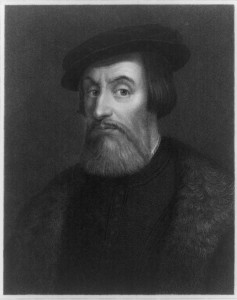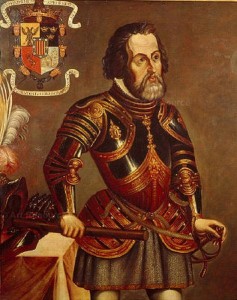Hernán Cortés (1485-1547), also known as Hernando Cortés was a Spanish Conquistador, born in Medellin, which is in the province of Castile of Spain. He was responsible for the bold conquest of the Aztec Empire in 1519 in Central Mexico. Hernán was the son of Doña Catalina Pizarro and Martín Cortés.
Hernán initially studied law at the University of Salamanca for 2 years, but later on he dropped out hoping to make a fortune in America. Hernán’s parents were opposed to his plans since they thought that he would have been equipped for a lucrative legal career after his studies. However, the 2 years of legal education would later on secure him the upper hand in justifying his unconstitutional conquest of Mexico.
Years in Hispaniola
By the time when Hernán was dropping out of the university, news of thrilling discoveries of Christopher Columbus in the New World was spreading quickly throughout Spain. The news likely motivated Hernán to leave Spain for the Americas. His initial plans were to sail to the Americas with Nicolas de Ovando, a distant relative and governor of Hispaniola.
In 1504 at the age of 19 years, he left Spain and sailed to Hispaniola, Santo Domingo island (current Dominican Republic). When Hernán arrived at Hispaniola, he registered as a citizen and acquired permission to own and build a plot of farmland.
Immediately after he settled down, Ovando gave made him a notary of the Azua de Compostela town. During the next 5 years, Cortés managed to establish himself in the colony. In 1506, he participated in the conquest of Cuba and Hispaniola and was rewarded with Indian slaves and a large estate of land for his contribution during the expedition. People referred to him as an intelligent administrator, ruthless fighter, and capable leader.
Life in Cuba
 In 1511, Cortés moved to Cuba, accompanying Diego Velázquez, governor at that time. Velázquez was on a mission to conquer Cuba. This expedition was marked by numerous, horrifying abuses, including massacres. Hernán became a clerk to the treasury at the age of 26 years and was held responsible for making sure that the Crown received the customary 1/5 of the earnings from the expedition. Velázquez was very impressed with Hernán and offered him a high political rank in the colony.
In 1511, Cortés moved to Cuba, accompanying Diego Velázquez, governor at that time. Velázquez was on a mission to conquer Cuba. This expedition was marked by numerous, horrifying abuses, including massacres. Hernán became a clerk to the treasury at the age of 26 years and was held responsible for making sure that the Crown received the customary 1/5 of the earnings from the expedition. Velázquez was very impressed with Hernán and offered him a high political rank in the colony.
Over the time, the relationship between Governor Velázquez and Cortés started to become strained. This worsened when Juan de Grijalva (Spanish conquistador) reached Velázquez to help him to set up a colony on the mainland. In October, 1518, Cortés was appointed as the captain-general of the newly found expedition and was advised to move rapidly before the governor changed his mind.
He managed to assemble 300 men and 6 ships within one month. On the other hand, the governor became jealous and decided to give the leadership of the mission to someone else. At the same time, Cortés was in a relationship with Catalina Juárez, Velázquez’s sister-in-law. At first, the governor was displeased with the relationship, but over time Hernán managed to marry Catalina.
Hernán Cortés established himself as an administrator and soldier and became the mayor of the city of Santiago, where he stayed until 1518.
Conquest of Tenochtitlan
From 1517 to 1518, Cortés had watched 2 missions fail in the attempt to conquer the mainland. In 1518, he persuaded Velázquez to make him the commander of an expedition to the mainland. Initially, Velázquez appointed Cortés to command the expedition, but later on he canceled his commission after he started to suspect Cortés’ motives. However, Cortés ignored this and set out.
By then, Mexico was being ruled by Aztec Empire under the leadership of Montezuma II. Cortés had gathered 600 in preparation to conquer the Aztec Empire. In March, 1519, he arrived at Tabasco where he camped with the intention of acquiring intelligence from the locals.
Cortes landed at the Mayan capital, Tenochtitlan on November 8, 1519. Here, he met Montezuma, who welcomed him and his small army of Spaniards. Cortés then informed Montezuma that he was seeking gold. Montezuma offered him so much that the Spaniards were tempted to seek for more. It is believed that Montezuma was setting Cortés and his army up and was planning to kill them.
Meanwhile, Velázquez was planning to capture Cortés and sent an expedition in April 1520. When Cortés left to fight Velázquez’s expedition, a revolt started in Tenochtitlan. Cortés returned to the city and asked Montezuma to order his people to end the revolt. Unfortunately, while addressing the crowd, Montezuma was struck by a stone and died. The Aztecs drove the Spaniards out of their city.
In the summer of 1521, Cortés regrouped and returned to capture the Mayan capital. He began by cutting off all supplies and fresh water routes to the capital, entering the city afterwards. Despite opposition by the Aztecs, he managed to eradicate the Aztec civilization by August 1521. He embarked on rebuilding the capital and renamed it Mexico City. Spain appointed him the governor of Mexico for his efforts.
Return to Spain
Mexico City was becoming a popular city as many Europeans started to migrate to the Americas. By then Hernán had already begun to rebuild the Aztec ruins. He also collected a lot of jewels and gold, garnering popularity back in Spain. In 1528, his fame spread like wildfire, and the government of Spain started to get worried that he was getting too powerful.
He was forced to go back to Spain where the king appointed him a captain-general. In 1530, he persuaded the king to send him back to Mexico and the king agreed. However, this time he would have less freedom and power than before. In 1536, he explored the northwestern region of Mexico where he discovered the Baja-California peninsula. This was his last major expedition.
Later Life and Death
In 1541, Hernán Cortés went back to Spain where he was served with many lawsuits, including alleged debts. He thought that the king would come to his aid, but the king ignored him. Due to his many debts, he made claim on the royal treasury in February 1544 but was awarded with a royal runaround for the next 3 years instead. He was disgusted by this gesture and decided to go back to Mexico in 1547. On reaching Seville, he got sick and died on December 2, 1547 at the age of 62. His body was buried in the mausoleum of Medina’s Duke in Seville. Since then, his remains have been moved more than 8 times.

